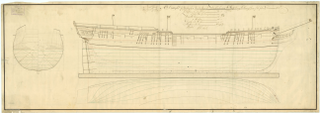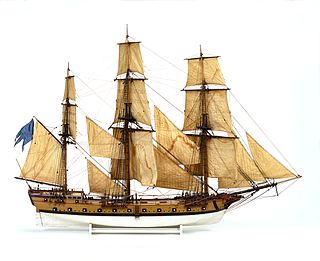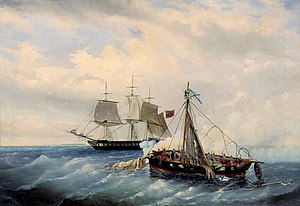
The Anglo-Russian War was a war between the United Kingdom and the Russian Empire which lasted from 2 September 1807 to 18 July 1812 during the Napoleonic Wars. It began after Russia signed the Treaty of Tilsit with the First French Empire, which ended hostilities between the two nations. During the war, actual military engagements were limited primarily to minor naval actions in the Baltic Sea and Barents Sea.

HMS Erebus was originally built as a Royal Navy fireship, but served as a sloop and was re-rated as such in March 1808. She served in the Baltic during the Gunboat and Anglo-Russian Wars, where in 1809 she was briefly converted to a fireship, and then served in the War of 1812. In 1814 she was converted to a rocket vessel to fire Congreve rockets. While serving off America, Erebus participated in the sack of Alexandria, Virginia, and launched the rockets that bombarded Fort McHenry in Baltimore on 13 September 1814. In March 1815, off Georgia, she fired the second-to-the-last-shot of the war. She was laid up in 1816 and sold for breaking up in 1819.

HMS Implacable was a 74-gun third-rate ship of the line of the Royal Navy. She was originally the French Navy's Téméraire-class ship of the line Duguay-Trouin, launched in 1800.

The Battle of Vyborg Bay was a naval battle fought between Russia and Sweden on 3 July 1790 in Vyborg Bay off the coast of Vyborg during the Russo-Swedish War (1788–1790). The Swedish Navy suffered heavy losses, losing seven ships of the line and three frigates, but Gustav III of Sweden eventually ensured a Swedish naval escape through a Russian naval blockade composed of units of the Baltic Fleet, commanded by Admiral Vasily Chichagov. British historians would later call the Battle of Vyborg Bay the "Baltic Trafalgar". The battle ranks among the world's largest historical naval battles and also among the most influential, as it introduced the naval battle concept of "firepower over mobility".

HMS Boadicea was a frigate of the Royal Navy. She served in the Channel and in the East Indies during which service she captured many prizes. She participated in one action for which the Admiralty awarded the Naval General Service Medal. She was broken up in 1858.

Constitution was a 74-gun Téméraire-class ship of the line of the French Navy launched as Viala in 1795. The Royal Navy captured her in 1806 and sold her in 1814.

HMS Centaur was a 74-gun third rate of the Royal Navy, launched on 14 March 1797 at Woolwich. She served as Sir Samuel Hood's flagship in the Leeward Islands and the Channel. During her 22-year career Centaur saw action in the Mediterranean, the Channel, the West Indies, and the Baltic, fighting the French, the Dutch, the Danes, and the Russians. She was broken up in 1819.

HMS Cerberus was a 32-gun fifth-rate frigate of the Royal Navy. She served in the French Revolutionary and the Napoleonic Wars in the Channel, the Mediterranean, the Adriatic, and even briefly in the Baltic against the Russians. She participated in one boat action that won for her crew a clasp to the Naval General Service Medal (NGSM). She also captured many privateers and merchant vessels. Her biggest battle was the Battle of Lissa, which won for her crew another clasp to the NGSM. She was sold in 1814.

HMS Frolic was an 18-gun Cruizer-class brig-sloop of the Royal Navy. She was built by Boole, of Bridport and was launched on 9 February 1806. Although she took part in the capture of Martinique, Guadaloupe, and Saint Martin, she appears to have had an uneventful career until 8 October 1812, when the American sloop-of-war USS Wasp captured her after a fierce fight. Later that day the British recaptured Frolic and captured Wasp. Frolic was broken up in 1813.

HMS Tartar was a 32-gun fifth-rate Narcissus-class frigate of the Royal Navy, built at Frindsbury and launched in 1801. She captured privateers on the Jamaica station and fought in the Gunboat War and elsewhere in the Baltic Sea before being lost to grounding off Estonia in 1811.

HMS Magnet was a Cruizer-class brig-sloop built at Robert Guillaume’s yard at Northam and launched in 1807. She served in the Baltic, where she took two prizes, one an armed privateer, before wrecking in 1809.

The Russian ship Vsevolod was a 74-gun ship of the line launched in 1796. She served in the North Sea and the Baltic until the British 74-gun third rates Implacable and Centaur destroyed her in 1808 during the Anglo-Russian War (1807–1812).

HMS Salsette was a Perseverance-class fifth-rate frigate of a nominal 36 guns, launched in 1805. The East India Company built her for the Royal Navy at the company's dockyards in Bombay. She was the Navy's first teak-built ship.

A hemmema was a type of warship built for the Swedish archipelago fleet and the Russian Baltic Fleet in the late 18th and early 19th centuries. The hemmema was initially developed for use against the Imperial Russian Navy in the Archipelago Sea and along the coasts of Svealand and Finland. It was designed by the prolific and innovative Swedish naval architect Fredrik Henrik af Chapman (1721–1808) in collaboration with Augustin Ehrensvärd (1710–1772), an artillery officer and later commander of the Swedish archipelago fleet. The hemmema was a specialized vessel for use in the shallow waters and narrow passages that surround the thousands of islands and islets extending from the Swedish capital of Stockholm into the Gulf of Finland.
HDMS Søormen was a 12-gun cutter of the Royal Dano-Norwegian Navy, built in 1789. After being captured by the British in 1808 she was added to the Royal Navy as HMS Salorman. She was wrecked in 1809.
HMS Fama was the Danish brig Fama, of fourteen guns, built in 1802, that the British captured in 1808. She was wrecked at the end of the year.
Puissant was built in 1781-82 to a design by Antoine Groignard as a Pégase class 74-gun ship of the line. Her captain handed her over to the British at Toulon on 29 August 1793. She arrived at Portsmouth on 3 May 1794. She then remained there as an unarmed receiving ship, sheer hulk, and flagship until her sale in 1816.

The French brig Voltigeur was a Palinure-class brig launched in 1804. The British captured her in 1806 and renamed her HMS Pelican. She was sold in 1812.

HDMS Allart, a brig launched at Copenhagen in June 1807, was amongst the ships taken by the British after the second Battle of Copenhagen. In British service, she was recaptured by Danish-Norwegian gunboats after venturing too close inshore. Her subsequent service was in the Dano-Norwegian Navy's Norwegian Brig Division, which harried enemy frigates and convoys in Norwegian waters. In 1812, she was captained by Ulrich Anton Schønheyder. His father was after the mother's death married to Joachime Catharine Benzon (1757-1836). On the separation of Denmark from Norway in 1814, Allart transferred to the Norwegian navy, who sold her in 1825.

HMS Moselle was a Cruizer-class brig-sloop of the Royal Navy, launched in 1804. She served during the Napoleonic Wars in the Mediterranean, the Caribbean, and the North American station. She was sold in 1815.
















